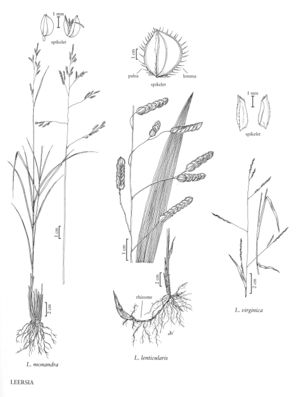Leersia monandra
Plants perennial; cespitose, without rhizomes. Culms 40-120 cm tall, 0.8-1.2 mm thick, erect, unbranched; nodes nearly glabrous to densely retrorsely hispidulose, adjacent portions of the internodes glabrous or mod¬erately retrorsely hispidulose. Sheaths glabrous or moderately retrorsely hispid-scabrous; ligules 1.5-4 mm; blades 20-30 cm long, 3.5-6 mm wide, ascending, usually involute on drying, veins and margins smooth or scabridulous. Panicles 5-15 cm, with 1 branch per node; branches spreading to somewhat ascending, spikelets closely appressed, confined to the distal 1/3 of the branches. Spikelets 1.5-2 mm long, 1-1.3 mm wide, laterally compressed, broadly elliptic or ovate. Lemmas and paleas glabrous, acute or obtuse; anthers 2. Caryopses 1-1.3 mm, ovate, yellow. 2n = 48.
Distribution
Puerto Rico, Fla., Tex.
Discussion
Leersia monandra grows in rather dry, rocky, limestone soils in open woods, grasslands, and bluffs, from Texas and Florida south to the Yucatan Peninsula, Mexico, and the Antilles. It is also sold as an ornamental. There have been few collections from the Flora region in the last two decades. In areas with heavy grazing, L. monandra tends to disappear, surviving only in areas where shrubs provide some measure of protection. It flowers throughout the year.
Selected References
None.
